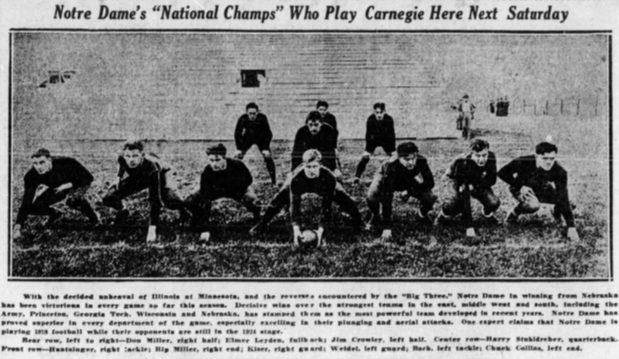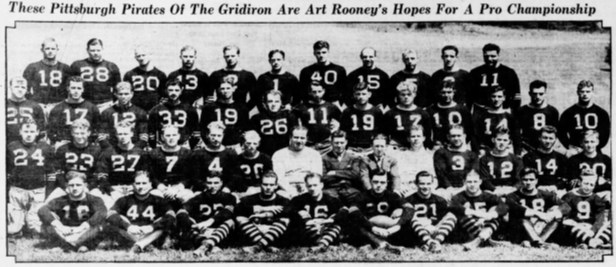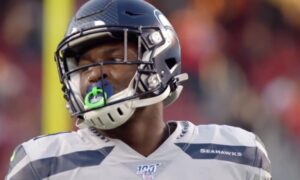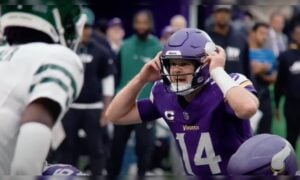Pittsburgh had its third coach going into season three of Pittsburgh Steelers history. Art Rooney, known as the “Prez” then; had opted for local college heroes and gave both their first opportunity to be a head coaches in his first two selections to lead the Pittsburgh football Pirates (Steelers).
Read more about them here:
Albert “Luby” DiMeollo article
The Prez went a slightly different direction with his third hire in as many seasons. Joe Bach was a college hero but not local. Born in Minnesota, Joe Bach played at Notre Dame with the famous Four Horsemen who won the national championship in 1924. As a starting tackle; he was one of the Seven Mules that played in front of the four horsemen.
Knute Rockne was a great football innovator but also launched many coaching careers. Twelve of his players from the 1924 national championship team, including Joe Bach, went on to coach football. Another of those players was Elmer Layden who later became the NFL commissioner. Layden had been one of the four horsemen that Bach blocked for.
Duquesne University hired Layden to be their head coach in 1927. He was an innovator like his mentor Knute Rockne. Some innovations credited to Layden include separate sets of home & away uniforms and hand signals to explain penalties to fans used by officials to this day according to the Duquesne University Football History. As the NFL commissioner, at the end of WWII he also asked all the NFL teams to continue playing the national anthem saying, ““The National Anthem should be as much a part of every game as the kick-off. We must not drop it simply because the war is over. We should never forget what it stands for.”
But Layden’s immediate impact on Pittsburgh’s professional football franchise was bringing Joe Bach to the city in 1929. Pat Regan resigned as assistant coach to join another of the four horsemen, Harry Stuhldreher who was coaching Villanova. Joe Bach was brought to be the assistant coach in charge of the linemen.
Art Rooney was well aware of a nationally known player from Notre Dame coming to coach in Pittsburgh. In fact, Joe Bach played at least two games for the Hope-Harvey Radio Majestics. A local football team that Art Rooney had been a player-coach and now ran as his own. It was a conglomeration of local neighborhood athletes, college players or anyone that looked like they could go for a few rounds. One of the games Bach was to play in was against the Charleroi Whippets. He was also paid $75 ($1081.25 in today’s dollars) to play against West View; however the game was suspended early when several fights broke out. Joe left, and Art Rooney sent someone to pay him which Joe initially refused since the game was not completed. Art insisted he keep the payout, saying we hardly finish any of our games anyways.
Those match-ups remind me of going to the Northside while a college student to visit a buddy from there. He invited me to play with a group from his neighborhood against another group from a few streets away. We played on a vacant lot that had more cinders than grass on it. Our team consisted of 15-20 guys from 14 years old to some guys in their 30’s. We had to buck up since the winner of the game won the pot. A full tackle game with no helmets or shoulder pads. The only guy I knew was my buddy Bob “Mole” Mueller but I was in since he vouched for me and said I was no snowflake; he used a different adjective that begins with a P. It was madness. But it kind of reminds me of how playing on those sandlot teams like the Hope Harvey’s might have been. You got your team and you just pummeled the other team until you could get the ball and finally score more than them. A very primitive; beastly affair but once it was over you really felt like you had lived as you iced the lumps on your noggin and bandaged the scrapes & cuts. That was around 1977 or 78. I wonder if they still have such neighborhood contests these days.
Another interesting intersection is a racial boundary. In Bach’s first year at Duquesne; they had 97 players trying out for the team including Ray Kemp who was one of their veteran tackles. He would survive cut downs and be noted several times for outstanding play for the Dukes that season. As line coach Bach would be very familiar with Kemp who would go on to play for Art Rooney’s semipro J.P. Rooney’s team (renamed from the Radio Majestics but same team) and then on the Steelers very first roster. Since Bach was playing for Art Rooney while he was coaching Kemp; I find it easy to imagine that they conversed about the good players on Duquesne’s team and thus may Bach have had influence on Kemp making it to the pros, however, I found no direct evidence in the articles I read.
Joe Bach became head coach at Duquesne in 1934 when Elmer Layden returned to Notre Dame to become head coach. Joe Bach signed a one-year contract and led Duquesne to a respectable 8-2 record. The only losses were to West Virginia University 0-7 and Carnegie Tech 0-3. Despite this success; Hayden’s contract was not renewed immediately. It was a confusing situation where Duquesne University professed confidence in Joe Bach but had promoted his assistant, Christy Flanagan to be athletic director. So, Bach’s assistant coach was also going to be his boss.
The controversy ran right up to Christmas with Art Rooney – a Duquesne alumnus saying he would sign Joe, if Duquesne didn’t want him. In the end, Joe Bach signed a three-year deal with Pittsburgh and doubled his annual salary on Christmas Day 1934.
The 1935 season would be the first of two coaching stints with the Steelers for Bach. He was 34 years old with five years as the assistant and one as head coach at Duquesne University when he took the helm. The roster limit rose to 24 players that year. Due to injuries and midseason releases; 38 different players would appear on the roster that season, including seven that had played for him at Duquesne University.
Here is the preseason snap of the 1935 team. The first head coach, Jap Douds is still there as a player (# 44). However, he would not appear in any regular season games.
The Steelers managed the best performance yet … 4-8. Pittsburgh had one more game in 1935; which was the second annual contest against local college all-stars (Bach had coached the college team in 1934). Art Rooney and Joe Bach used this as an opportunity to scout out local talent. While the 1935 results were mediocre there was an optimistic outlook going into the 1936 season. The NFL announced the schedule on August 11th noting that each team would play 12 regular season games with the Pirates (Steelers) hosting the Boston Redskins on September 13th and closing out their season on December 6th at Philadelphia. The winners of the Eastern & Western Divisions would play for the NFL championship on December 13th with the East hosting the game.
Pittsburgh started out strong with three stright victories over Boston, Brooklyn Dodgers and New York Giants. After two losses to the Bears and one to Green Bay; Pittsburgh was 4-3 and still in contention for the Eastern Division crown at the end of October. But they faced a brutal stretch to start November. Philadelphia agreed to move their home game scheduled for December 6th to November 5th at Johnstown, Pa. “It was shifted to Johnstown through the efforts of the local Recreation Commission, of which Cad Reese, assistant coach of the Pirates, is director.” This put the game closer to home but meant that the Steelers had to play Brooklyn on Sunday; Philadelphia on Wednesday and then travel to Detroit to play the Lions the following Sunday – three games in one week.
Pittsburgh beat Brooklyn but lost three players to injury; the Wednesday game was rained out so was played on Thursday night. This gave an extra day to heal but cost a day preparation for the Lions which was a long train ride in those days. Pittsburgh managed to beat the Eagles to secure the Eastern Division lead but were unsurprisingly thumped by the Lions in the 3rd game played in a week that included train travel to Detroit.
Pittsburgh then travelled onto to Chicago for a match versus the 1-7 Cardinals. Win this match and Pittsburgh could clinch the Eastern Division with their 7th win. It was not to be. The Cardinals upset Pittsburgh 14-6 for only their 2nd win of the season.
Still, the Steelers had one more game and would win the Eastern Division and be host to the NFL championship game if they beat Boston who they had beat on opening day in Pittsburgh. Pittsburgh had a bye the previous week. But in those days; NFL teams would play exhibition games. The Steelers travelled all the way out to Los Angeles by train to play the Los Angeles Bulldogs which was a “probationary NFL franchise” (they would be passed over in favor of the Cleveland Rams for the 1937 season). Bach told his players to avoid injuries and they played like it; losing 7-27. A long train ride back to Pittsburgh got them home around the 25th in time to go to Boston where they got thumped 0-30.
With a championship game on the line; I’m not sure if I would have taken my team on a cross country train trip to play an exhibition team – but that’s just me. Pittsburgh still could have won the division if Boston lost to the Giants the following week but as another team from New England has done so many times, they won and broke the hearts of Pittsburghers hoping for a championship in their 4th season in the league.
December also saw Pittsburgh participate in the second NFL draft picking Mike Basrak an all-American from Duquesne University as their top pick. However, rumors were already circulating that Bach wanted to return to coaching college football. A December 14, 1936 Post-Gazette article mentioned, “Joe Bach is with Rooney in New York negotiating for other players, although Bach is not certain to be here next season. Rooney wants him to return it is understood, but Bach is open for a job with a major college eleven if one comes his way.”
That was good gouge as Bach resigned in early February to take the head coach job at Niagara University despite a close relationship with Art Rooney. In fact, Rooney would be the best man at Bach’s wedding one week after he quit the team.
Bach’s tenure at Niagara would not last long as the University suspended the football program due to the war. In 1942, the Pittsburgh Courier reported that Joe Bach was coaching an integrated military team called the Fort Knox Armoraiders. They played at least one exhibition game against the Steelers that year. Bach then hooked up as an assistant coach to the Detroit Lions from 1943-47. In 1950 he became head coach at Saint Bonaventure where he coached future Steelers Jack Butler and Ted Marchibroda. Butler was picked up as an undrafted rookie in 1951. Bach had to have some influence there. Butler would go on to a Hall of Fame career as a Pittsburgh Steeler player and then scout. As luck would have it, Saint Bonaventure shut down its football program in 1951 leaving Bach high and dry – though they did offer him the athletic director job.
Pittsburgh was still reeling from the untimely death of Jock Sutherland. The Steelers were still playing the single wing – the last team in the NFL to do so. Joe Bach was hired for a second stint as Steelers head coach; Art Rooney signing him to a three-year contract. The previous coach had been playing a college quarterback named Jim Finks as a defensive back but in emergencies would throw the ball on offense. Bach continued this practice in his first season but saw the potential he had in a passing quarterback. The Steelers has a lackluster 5-7 record with just the Cardinals and Redskins below them in their division. In 1953, Joe Bach installed the T formation putting Finks behind center; who in turn, led the league with 334 passing attempts & 20 touchdowns and a pro Bowl berth. The Steelers finished 6-6 but the new offense had the team looking forward to improving the next year.
Bach was set to coach his third season with expectations high for a winning season. But after three straight preseason losses; and “noisy fans … alternately booing Coach Joe Bach, quarterback Jimmy Finks and Fullback Franny Rogel.” He suddenly resigned.
That was front page news in Pittsburgh:
This pretty much ended Joe Bach’s football career, though Art Rooney offered him a scouting job. Curly Lambeau was fired the week before when the Redskins lost an exhibition game. Apparently, winning these preseason games were important to attract more fans to pay at the gate. As Art Rooney remarked after Bach’s resignation, “The pressure is just too tough now. In the old days a win or loss didn’t matter too much. Now, it’s a cold-blooded business.”
Joe Bach’s career 21-27 record as the Steelers head coach does not credit the legacy that he left the Steelers. Bach steered the Steelers within one win of going to the NFL championship in their 4th season. Bach introduced the Steelers to the modern game with the installation of the T formation making Jim Finks (a future Hall of Famer as a contributor) the first quarterback playing behind center for the franchise. He brought talent to the club like Hall of Famer Jack Butler.
Bach also chaired the committee that changed the name of the franchise from the Pirates to the Steelers in 1940. Bach was also an early champion of integrating football. He had coached Ray Kemp in college when many programs were segregated. Kemp would go on to become the Steelers only black player on their inaugural team. He kept contact with Kemp; presiding at Ray Kemp’s 1st Mountaineer athletic clinic for West Virginia high school coaches at Bluefield College in 1935. As mentioned before, he coached an integrated team at Fort Knox in 1942. The Pittsburgh Courier quoted Bach in 1953, “We are not interested in a man’s color. We are interested in good football players, men who can help us solve our problems in fielding a sound football team.”
Art Rooney said this about Joe Bach, “In your lifetime, you make mistakes. Well, letting Joe Bach get away that first time was the biggest mistake I think I made.” That is quite a tribute. Joe Bach was not a Pittsburgher by birth; but I believe he became one pretty much making it his home base from the time he arrived in 1929 with much fanfare. He also left with fanfare. On October 24, 1966, he was inducted into the Pittsburgh Curbstone Coaches Hall of Fame. Just five minutes after receiving his award and reciting The Four Horsemen by Grantland Rice, Joe Bach collapsed and died of a heart attack at age 65.
He didn’t live to see the success of the 1970’s Steelers though he was part of the legacy that led to it. He got to see the highs and the lows of the Pirates, then helped rename them the Steelers and introduced quarterbacking to the team as we know it today; but if I could; I would have told him back then; You Ain’t Seen Nothing Yet.











